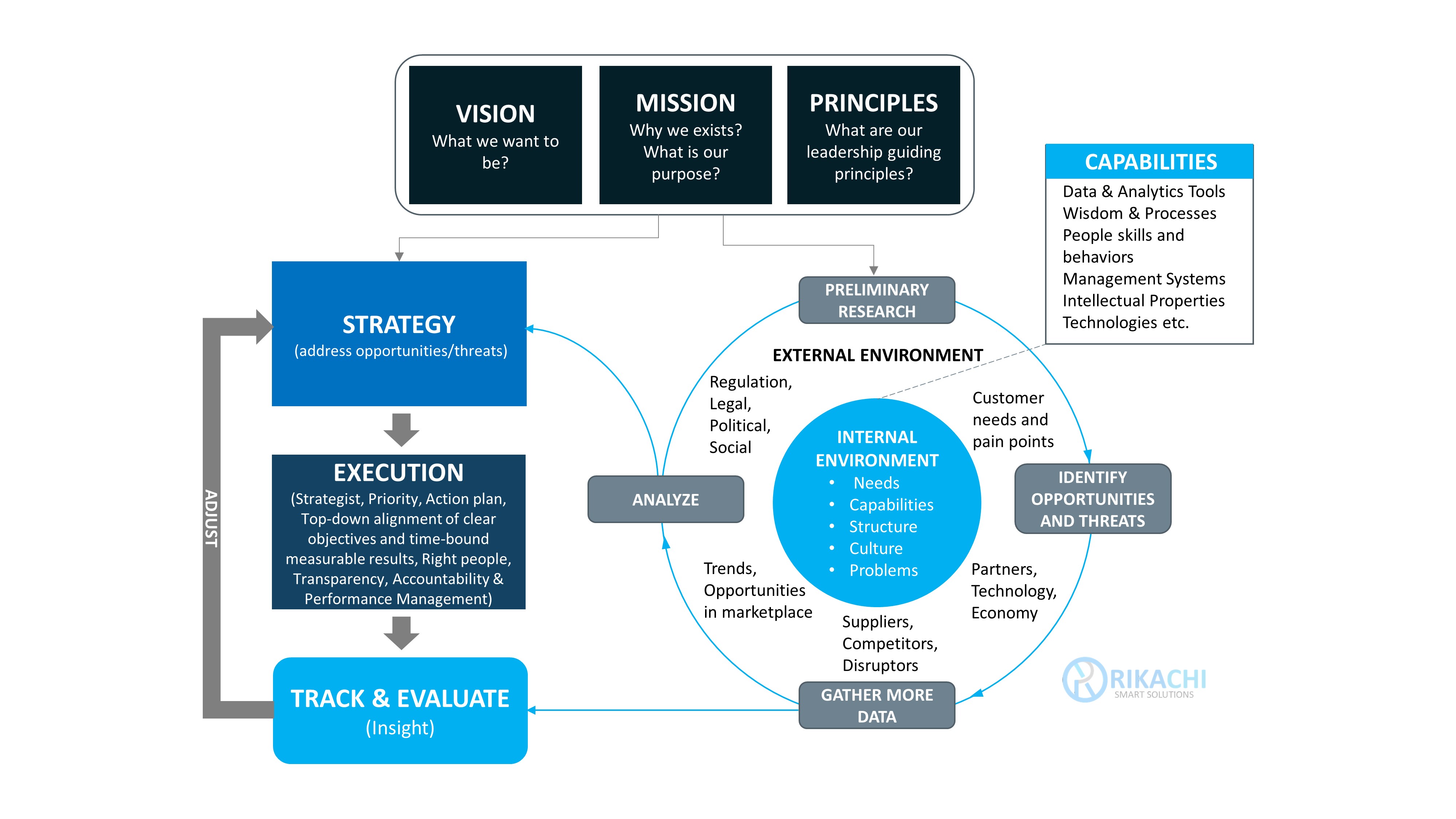4 Tips to Maximize Value with Advanced Analytics
Although there is a greater emphasis on Artificial Intelligence (AI) and big data tools, organizations need to use these technology tools as the means to an end. In other words, the purpose for the organization's existence and clear destination of what it wants to achieve in the long run should be the basis for adopting these technology tools. That requires organizations to first identifying organizational core competencies, goals, and needs. Then, to use problems and goals as the guide to find cost-effective solutions that can do the job well. Without strategic adoption of technology tools, an organization could be chasing new shiny objects that will not maximize the value.
Tip #1: Focus on the Vision & use Insights as an Accelerator to Maximize Long-term Value
Vision without action is merely a dream. Action without vision just passes the time. Vision with action can change the world.-- Joel A. Barker

Figure 1: Vision Focused Data-driven Strategy
Maximizing long-term business value requires a corporate strategy to realize the vision. Organizations like Apple, Johnson & Johnson, Microsoft, Toyota, and Walmart focus on their vision and use AI/Big Data tools as the means to an end. These organizations are high performers with high returns on investment (ROI) in innovation. They continuously broaden and deepen their core competencies to meet customer needs. They also have great leaders, talented employees, and top-notch analytics systems. Their capabilities allow them to innovate products and services to satisfy and exceed their customers' needs. They also help them to have innovative supply chain management, marketing, and business models. Hence, the ability to become market leaders through the discipline of using insights to take actions to maximize long-term value.
In short, the organization needs to have the capabilities to assess and reassess its business environments. To use the insights from assessment to address challenges and opportunities in its environment. Having tools to acquire, prepare, integrate, and analyze data is crucial for organizational success. Indeed, cross-silos business insights and 360° customer insights can allow an organization to make evidence-based decisions, plan well, improve performance and adjust to realize its vision as its business environment change.
“Your customers are the lifeblood of your business. Their needs and wants impact every aspect of your business, from product development to content marketing to sales to customer service.”-- John Rampton
Capabilities to maximize customer and business values are essential to be the market leader in a hypercompetitive world. The intelligent systems to understand customer needs, trends, pain points, and behaviors play a vital role in the innovation or improvement of the products/services. Moreover, it is crucial to have the means to identify competitor threats and opportunities in emerging markets and take corrective actions to achieve the strategic objectives. Equally important are insights to streamline the supply chain and create value-based marketing. Overall, the initiatives will help to reduce costs and risks as well as increase revenue.
For example, Tim Cook led the streamlining of Apple’s supply chain before becoming Apple’s COO and later CEO in 2011. He helped to reduce the number of suppliers and inventory. Apple also negotiates long-term deals with suppliers. As a result, they reduce supply chain costs and risks. Apple supply chain management is part of its competitive advantage. [3][4]10] Additionally, Apple has top-notch industrial design and marketing capabilities.
Tip #2: Foster Principle-based Processes and Culture
The data-driven business transformation requires the organization to have the right leaders, culture, structure, and management systems to realize the vision. Leadership principles are the foundation that helps to shape systems and culture. They guide decision-making and core behaviors of leaders and hence influence culture. They can help to identify the right leaders who are passionate about the mission. Thus, the organization can have the ability to bring the right leader on board and the wrong ones out.
“Leadership is about having principles. A leader must have a vision and principles that will endure for all time and must always be true to these principles, applying them to changing circumstances.”-- Margaret Thatcher
For example, the current Amazon’s leadership principles include: customer obsession, invent, and simplify, earn trust, bias to action, dive deep, and deliver results. These well-thought leadership principles enable Amazon to achieve its strategic goals. They are guidelines that help to bring the right leaders with the desired behaviors on board. They also act as a guideline for leaders to make tough decisions.
Tip #3: Align Vision, Mission and Principles
Every great thing built or achieved by a group of people had a vision and successful strategy execution. Data play a vital role in formulating, executing, and evaluating the strategy. However, if the mission, vision, and guiding principles are not aligned, the execution is bound to fail when things get tough. As humans, we need purpose, motivation, and guidelines to change and succeed. A clear mission and vision can motivate the right people to commit to do the right thing and achieve greatness.
“Teamwork is the ability to work together toward a common vision. The ability to direct individual accomplishments toward organizational objectives. It is the fuel that allows common people to attain uncommon results. “-- Andrew Carnegie
Amazon is among the companies with alignment on its mission, vision, and leadership principles. In essence, their support system enables them to achieve high performance through excellent execution. Other high performers that have alignment are Walmart, Toyota, Apple, Microsoft, and Google. Indeed, the alignment of a clear vision, mission and principles, and successful execution of data-driven strategy is key to differentiation.
Tip #4: Use Intelligence to Formulate, Execute, and Evaluate Strategy
Relying entirely on the feelings without taking into consideration the available evidence to make decisions is too risky. The insights from data is required to formulate, execute, and evaluate strategy. Identifying opportunities and threats in business environments to create the strategy require assessment and reassessment of an internal and external world. It also requires engaging multiple stakeholders to solicit diverse inputs. The combined insights help to reduce emotional and cognitive blind spots and increase buy-in of the strategy.
“To me, ideas are worth nothing unless executed. They are just a multiplier. Execution is worth millions.”--Steve Jobs
A good strategy that lacks successful execution does not add value. Indeed, excellent strategy execution is the key to operational excellence. However, several case studies have indicated that a large percentage of strategy execution fails.[2][7][18] They fail due to a lack of strategic alignment, buy-in, or accurate assessment and reassessment of internal and external business environments.
Successful execution requires an engaged leader. To articulate and rearticulate the strategy and the rationale behind it. The leader ought to set clear goals, prioritization, and create actions plan with milestones while ensuring strategic alignment. The top-down alignment of clear objectives and measurable results that are time-bound is key to success. Also important is the ability to allocate resources rationally to achieve strategic goals. The right skilled people and systems to support desired behavior are crucial for success. The ability to manage performance, reassess the business environment and adjust accordingly is necessary for successful execution.
Insights inform the teams and leaders about the changes in the business environment and their performance. However, without measuring the right things, the team could adjust to the wrong track. Thus, the team needs to be accountable for the performance of the results. To use the right metrics and assess their performance qualitatively and quantitively with the leader. The team should learn and take corrective measures to reduce the gap between the desired results and performance. The leader should also motivate the team based on performance. Eventually, in the long run, the discipline of actions to achieve objectives iteratively and adjust accordingly to realize the vision will lead to deeper and broader competencies and result in a compound effect.
Conclusion
Insights and discipline for excellent execution of a strategy give a competitive advantage. Organizations need to adopt advanced analytics tools in a way that enables them to solve their problems and achieve broader goals. To Take advantage of insights to plan well, enhance decision-making, improve performance, and adjust to changes in environments without losing focus on the vision. To also use principles as a guideline to bring the right people on board, create the right processes and systems to enforce and support desired behaviors. Moreover, to continuously build distinctive capabilities to tackle future challenges and opportunities and maximize long-term business value.
References
1. 5 Keys to Successful Strategy Execution, Catherine Cote, 2020, https://online.hbs.edu/blog/post/strategy-execution
2. 20 Reasons Why Strategy Execution Fails, Jeroen Kraaijenbrink, 2019, https://www.forbes.com/sites/jeroenkraaijenbrink/2019/09/10/20-reasons-why-strategy-execution-fails/?sh=5b41751b1ebe
3. A case study of Apple's supply chain, Australian Institute of Company Directors ,2015, https://aicd.companydirectors.com.au/advocacy/governance-leadership-centre/governance-driving-performance/a-case-study-of-apples-supply-chain
4. Apple Supply Chain - The Best Supply Chain in the World, Clara Lu, 2020, https://www.tradegecko.com/blog/supply-chain-management/apple-the-best-supply-chain-in-the-world
5. Blue Ocean Strategy: How to Create Uncontested Market Space and Make Competition Irrelevant - W. Chan Kim & Renee Mauborgne (Gildan Media, LLC, 2011
6. Dynamic Capabilities, https://www.davidjteece.com/dynamic-capabilities
7. Executives Fail to Execute Strategy Because They’re Too Internally Focused, Ron Carucci, 2017, https://hbr.org/2017/11/executives-fail-to-execute-strategy-because-theyre-too-internally-focused
8. Execution: The Discipline of Getting Things Done - Larry Bossidy & Ram Charan (Random House Audio, 2002)
9. Good to Great: Why Some Companies Make the Leap and Others Don't Hardcover – Jim Collins (Unabridged, October 16, 2001)
10. How the Apple Supply Chain Stays Top Ranked in the World, Laura Ross, 2020, https://www.thomasnet.com/insights/apple-supply-chain/
11. Managing asset orchestration: A processual approach to adapting to dynamic environments, Svante Schriber⁎ , Jan Löwstedt, Stockholm Business School, 106 91 Stockholm, Sweden 2018
12. Measure What Matters: How Google, Bono, and the Gates Foundation Rock the World with OKRs - John Doerr (Penguin Audio, 2018)
13. Purpose, Mission and Values Alignment: Beehive’s Guide to Driving Meaningful Strategic Growth, January 23, 2020 | by Beehive, https://beehivepr.biz/purpose-mission-values-alignment/
14. Strategy That Works: How Winning Companies Close the Strategy-to-Execution Gap - Paul Leinwand, & Cesare R. Mainardi (Recorded Books, 2017)
15. The 4 Disciplines of Execution: Achieving Your Wildly Important Goals - Sean Covey, Chris McChesney & Jim Huling (Simon & Schuster Audio, 2013)
16. The Importance Of Having A Mission-Driven Company, William Craig, 2018, https://www.forbes.com/sites/williamcraig/2018/05/15/the-importance-of-having-a-mission-driven-company/?sh=168804663a9c
17. Tim Cook, the man who really saved Apple, Carolyn Ruocco, 2018, https://nomadiclearning.com/blog/2018/06/tim-cook-the-man-who-really-saved-apple
18. Why Strategies Fail, Dr. Arnoud van der Maas, 2014, https://strataegos.com/why-strategies-fail/
 Hendrika Kuffar
Hendrika Kuffar